Garmin G1000 User Manual

G1000TM
Pilot’s Guide for Beechcraft 58/G58

|
|
Part Number |
|
Change Summary |
|
|
|
|
|
190-00629-00 |
|
|
|
|
|
|
|
Rev.A |
|
|
|
|
|
|
|
190-00629-00 |
Corrected figure numbering sequence in Section 7 |
|
|||
|
|
Rev. B |
|
|
|
|
|
|
|
|
|
|
|
|
|
|
|
|
|
Record of Revisions |
|
|
|
|
|
|
|
|
|
||
Revision |
Date of Revision |
Revision Page Range |
|
Description |
|
||
A |
10/18/05 |
|
------------- |
Initial release |
|
|
|
B |
11/09/05 |
|
All |
|
|
|
|
|
|
|
|
|
|
|
|
Garmin G1000 Pilot’s Guide for Beechcraft 58/G58 |
190-00629-00 Rev. B |

COPYRIGHT
Copyright © 2005 Garmin Ltd. or its subsidiaries. All rights reserved.
This manual reflects the operation of System Software version 0500.01 or later.
Garmin International, Inc., 1200 East 151st Street, Olathe, Kansas 66062, U.S.A.
Tel: 913/397.8200 |
Fax: 913/397.8282 |
Garmin AT, Inc., 2345 Turner Road SE, Salem, OR 97302, U.S.A. |
|
Tel: 503/391.3411 |
Fax 503/364.2138 |
Garmin (Europe) Ltd., Unit 5,The Quadrangle,Abbey Park Industrial Estate, Romsey, Hampshire S051 9DL, U.K. |
|
Tel: 44/0870.8501241 |
Fax: 44/0870.8501251 |
Garmin Corporation, No. 68, Jangshu 2nd Road, Shijr,Taipei County,Taiwan |
|
Tel: 886/02.2642.9199 |
Fax: 886/02.2642.9099 |
Web Site Address: www.garmin.com
Except as expressly provided herein, no part of this manual may be reproduced, copied, transmitted, disseminated, downloaded or stored in any storage medium, for any purpose without the express written permission of Garmin. Garmin hereby grants permission to download a single copy of this manual and of any revision to this manual onto a hard drive or other electronic storage medium to be viewed for personal use, provided that such electronic or printed copy of this manual or revision must contain the complete text of this copyright notice and provided further that any unauthorized commercial distribution of this manual or any revision hereto is strictly prohibited.
Garmin® is a registered trademark of Garmin Ltd. or its subsidiaries, and G1000™ is a trademark of Garmin Ltd. or its subsidiaries. These trademarks may not be used without the express permission of Garmin.
Bendix/King® and Honeywell® are registered trademarks of Honeywell International, Inc., Silver Crown Plus™ is a trademark of Honeywell International, Inc.; NavData® is a registered trademark of Jeppesen, Inc.; Stormscope® and Skywatch® are registered trademarks of L-3 Communications;TCAD® is a registered trademark of Ryan International, Inc.; and XM® is a registered trademark of XM Satellite Radio, Inc.
November 2005 |
190-00629-00 Rev. B |
Printed in the U.S.A. |
190-00629-00 Rev. B |
Garmin G1000 Pilot’s Guide for Beechcraft 58/G58 |
i |

WARNINGS & CAUTIONS
WARNING: Navigation and terrain separation must NOT be predicated upon the use of the terrain function. The G1000 Terrain Proximity feature is NOT intended to be used as a primary reference for terrain avoidance and does not relieve the pilot from the responsibility of being aware of surroundings during flight. The Terrain Proximity feature is only to be used as an aid for terrain avoidance and is not certified for use in applications requiring a certified terrain awareness system. Terrain data is obtained from third party sources. Garmin is not able to independently verify the accuracy of the terrain data.
WARNING: The displayed minimum safe altitudes (MSAs) are only advisory in nature and should not be relied upon as the sole source of obstacle and terrain avoidance information. Always refer to current aeronautical charts for appropriate minimum clearance altitudes.
WARNING: The Garmin G1000, as installed in Beechcraft 58/G58 aircraft, has a very high degree of functional integrity. However, the pilot must recognize that providing monitoring and/or self-test capability for all conceivable system failures is not practical. Although unlikely, it may be possible for erroneous operation to occur without a fault indication shown by the G1000. It is thus the responsibility of the pilot to detect such an occurrence by means of cross-checking with all redundant or correlated information available in the cockpit.
 WARNING: For safety reasons, G1000 operational procedures must be learned on the ground.
WARNING: For safety reasons, G1000 operational procedures must be learned on the ground.
WARNING: The altitude calculated by G1000 GPS receivers is geometric height above Mean Sea Level and could vary significantly from the altitude displayed by pressure altimeters, such as the GDC 74A Air Data Computer, or other altimeters in aircraft. GPS altitude should never be used for vertical navigation. Always use pressure altitude displayed by the G1000 PFD or other pressure altimeters in aircraft.
WARNING: The Jeppesen database used in the G1000 system must be updated regularly in order to ensurethatitsinformationremainscurrent. Updatesarereleasedevery28days. Adatabaseinformation packet is included in the G1000 package. Pilots using an outdated database do so entirely at their own risk.
ii |
Garmin G1000 Pilot’s Guide for Beechcraft 58/G58 |
190-00629-00 Rev. B |
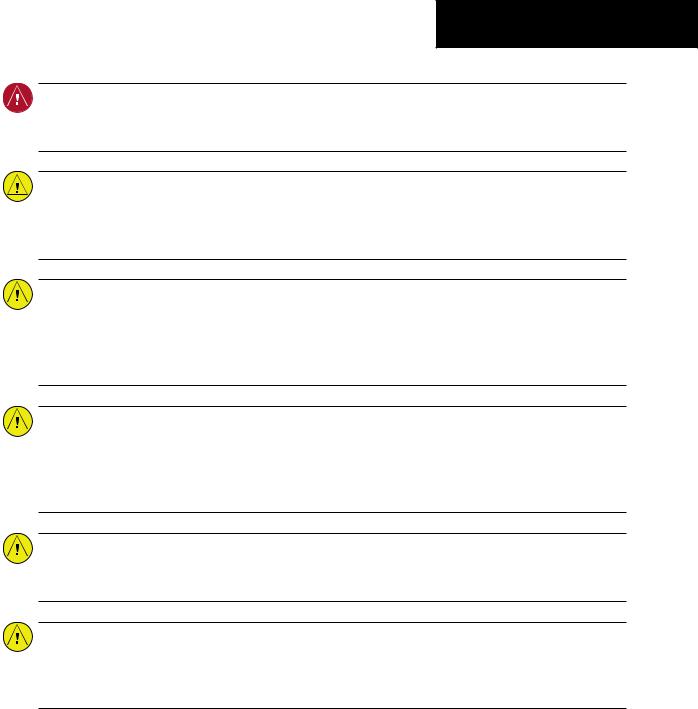
WARNINGS & CAUTIONS
WARNING: The basemap (land and water data) must not be used for navigation,but rather only for nonnavigational situational awareness. Any basemap indication should be compared with other navigation sources.
CAUTION:The illustrations in this guide are only examples. Never use the G1000 to attempt to penetrate a thunderstorm. Both the FAA Advisory Circular, Subject:Thunderstorms, and the Airman’s Information Manual (AIM) recommend avoiding “by at least 20 miles any thunderstorm identified as severe or giving an intense radar echo.”
CAUTION:TheUnitedStatesgovernmentoperatestheGlobalPositioningSystemandissolelyresponsible for its accuracy and maintenance. The GPS system is subject to changes which could affect the accuracy and performance of all GPS equipment. Portions of the Garmin G1000 utilize GPS as a precision electronic NAVigation AID (NAVAID). Therefore, as with all NAVAIDs, information presented by the G1000 can be misused or misinterpreted and, therefore, become unsafe.
CAUTION: To reduce the risk of unsafe operation, carefully review and understand all aspects of the G1000 Pilot’s Guide documentation. Thoroughly practice basic operation prior to actual use. During flight operations, carefully compare indications from the G1000 to all available navigation sources, including the information from other NAVAIDs, visual sightings, charts, etc. For safety purposes, always resolve any discrepancies before continuing navigation.
CAUTION: The Garmin G1000 does not contain any user-serviceable parts. Repairs should only be made by an authorized Garmin service center. Unauthorized repairs or modifications could void both the warranty and the pilot’s authority to operate this device under FAA/FCC regulations.
CAUTION: The GDU 1040 PFD and MFD displays use a lens coated with a special anti-reflective coating that is very sensitive to skin oils, waxes, and abrasive cleaners. CLEANERS CONTAINING AMMONIA WILL HARM THE ANTI-REFLECTIVE COATING. It is very important to clean the lens using a clean, lintfree cloth and an eyeglass lens cleaner that is specified as safe for anti-reflective coatings.
190-00629-00 Rev. B |
Garmin G1000 Pilot’s Guide for Beechcraft 58/G58 |
iii |

WARNINGS & CAUTIONS
 NOTE: All visual depictions contained within this document,including screen images of the G1000 panel and displays, are subject to change and may not reflect the most current G1000 system. Depictions of equipment may differ slightly from the actual equipment.
NOTE: All visual depictions contained within this document,including screen images of the G1000 panel and displays, are subject to change and may not reflect the most current G1000 system. Depictions of equipment may differ slightly from the actual equipment.
 NOTE: This device complies with part 15 of the FCC Rules. Operation is subject to the following two conditions: (1) this device may not cause harmful interference, and (2) this device must accept any interference received, including interference that may cause undesired operation.
NOTE: This device complies with part 15 of the FCC Rules. Operation is subject to the following two conditions: (1) this device may not cause harmful interference, and (2) this device must accept any interference received, including interference that may cause undesired operation.
 NOTE: There are several atmospheric phenomena in addition to nearby thunderstorms that can cause isolated discharge points in the strike display mode. However, clusters of two or more discharge points in the strike display mode do indicate thunderstorm activity if these points reappear after the screen has been cleared. Avoid the clusters to avoid the thunderstorms. In the cell display mode,even a single discharge point may represent thunderstorm activity and should therefore be avoided.
NOTE: There are several atmospheric phenomena in addition to nearby thunderstorms that can cause isolated discharge points in the strike display mode. However, clusters of two or more discharge points in the strike display mode do indicate thunderstorm activity if these points reappear after the screen has been cleared. Avoid the clusters to avoid the thunderstorms. In the cell display mode,even a single discharge point may represent thunderstorm activity and should therefore be avoided.
iv |
Garmin G1000 Pilot’s Guide for Beechcraft 58/G58 |
190-00629-00 Rev. B |

WARRANTY
LIMITED WARRANTY
This Garmin product is warranted to be free from defects in materials or workmanship for two years from the date of purchase. Within this period, Garmin will, at its sole option, repair or replace any components that fail in normal use. Such repairs or replacement will be made at no charge to the customer for parts and labor, provided that the customer shall be responsible for any transportation cost. This warranty does not cover failures due to abuse, misuse, accident, or unauthorized alterations or repairs.
THEWARRANTIESAND REMEDIES CONTAINED HEREINARE EXCLUSIVEAND IN LIEU OFALL OTHERWARRANTIES EXPRESS OR IMPLIED OR STATUTORY, INCLUDING ANY LIABILITY ARISING UNDER ANY WARRANTY OF MERCHANTABILITY OR FITNESS FOR A PARTICULAR PURPOSE, STATUTORY OR OTHERWISE. THIS WARRANTY GIVES YOU SPECIFIC LEGAL RIGHTS,WHICH MAY VARY FROM STATE TO STATE.
IN NO EVENT SHALL GARMIN BE LIABLE FOR ANY INCIDENTAL, SPECIAL, INDIRECT OR CONSEQUENTIAL DAMAGES,WHETHER RESULTING FROM THE USE, MISUSE, OR INABILITY TO USE THIS PRODUCT OR FROM DEFECTS IN THE PRODUCT. Some states do not allow the exclusion of incidental or consequential damages, so the above limitations may not apply to you.
Garmin retains the exclusive right to repair or replace the unit or software, or to offer a full refund of the purchase price, at its sole discretion. SUCH REMEDY SHALL BE YOUR SOLE AND EXCLUSIVE REMEDY FOR ANY BREACH OF WARRANTY.
To obtain warranty service, contact your local GarminAuthorized Service Center. For assistance in locating a Service Center near you, visit the Garmin Web site at “http://www.garmin.com” or contact Garmin Customer Service at 800-800-1020.
190-00629-00 Rev. B |
Garmin G1000 Pilot’s Guide for Beechcraft 58/G58 |
v |

WARRANTY
This page intentionally left blank.
vi |
Garmin G1000 Pilot’s Guide for Beechcraft 58/G58 |
190-00629-00 Rev. B |

|
SECTION 1 SYSTEM OVERVIEW |
|
|
|
|
1.1 |
Introduction.................................................... |
1-1 |
1.2 |
System Description......................................... |
1-1 |
1.3 |
Optional Equipment ....................................... |
1-3 |
1.4 |
PFD/MFD Controls .......................................... |
1-4 |
1.5 |
Secure Digital Cards....................................... |
1-6 |
1.6 |
System Power-up............................................ |
1-7 |
1.7 |
Display Backlighting....................................... |
1-9 |
1.8 |
System Operation........................................... |
1-9 |
|
Normal Mode............................................................. |
1-9 |
|
Reversionary Mode .................................................. |
1-10 |
|
AFCS PreflightTest................................................... |
1-10 |
|
AHRS Operation....................................................... |
1-11 |
|
|
|
|
SECTION 2 PRIMARY FLIGHT DISPLAY |
|
|
|
|
2.1 |
Introduction.................................................... |
2-1 |
2.2 |
Backlighting ................................................... |
2-4 |
2.3 |
Softkey Function ............................................ |
2-5 |
2.4 |
Flight Instruments.......................................... |
2-9 |
|
Airspeed Indicator...................................................... |
2-9 |
|
Attitude Indicator..................................................... |
2-10 |
|
Altimeter.................................................................. |
2-12 |
|
Vertical Deviation/Glideslope Indicator .................... |
2-14 |
|
Marker BeaconAnnunciations.................................. |
2-14 |
|
Vertical Speed Indicator ........................................... |
2-14 |
|
Horizontal Situation Indicator .................................. |
2-15 |
2.5 |
Communication, Navigation, & Surveillance |
|
(CNS)2-21 |
|
|
|
Communication FrequencyWindow......................... |
2-21 |
|
Navigation FrequencyWindow................................. |
2-21 |
|
Navigation Status Bar .............................................. |
2-22 |
|
Transponder (XPDR) Status Bar................................ |
2-22 |
2.6 |
Supplemental Flight Data.............................. |
2-23 |
|
OutsideAirTemperature Box.................................... |
2-23 |
|
TABLE OF CONTENTS |
||
|
|
|
|
SystemTime Box ...................................................... |
2-23 |
|
|
Inset Map................................................................. |
2-23 |
|
|
AuxiliaryWindow Keys............................................. |
2-26 |
|
|
Working with Menus................................................ |
2-27 |
|
|
AuxiliaryWindows.................................................... |
2-27 |
|
|
2.7 Reversionary Mode ....................................... |
2-42 |
|
|
2.8 Alerts and Annunciations............................... |
2-43 |
|
|
AlertsWindow.......................................................... |
2-43 |
|
|
AnnunciationWindow.............................................. |
2-43 |
|
|
SoftkeyAnnunciations.............................................. |
2-43 |
|
|
TerrainAwareness andWarning System (TAWS)Alert |
|||
Annunciations (optional).......................................... |
2-44 |
|
|
TrafficAnnunciation ................................................. |
2-44 |
|
|
|
|
|
|
SECTION 3 NAV/COM |
|
|
|
|
|
|
|
3.1 NAV/COM Description .................................... |
3-1 |
|
|
Windows and Fields ................................................... |
3-2 |
|
|
Radio Selection........................................................... |
3-2 |
|
|
Controls...................................................................... |
3-3 |
|
|
Tuning Box ................................................................. |
3-4 |
|
|
Switching Between Radios......................................... |
3-4 |
|
|
ManuallyTuning a Frequency..................................... |
3-4 |
|
|
Radio Indicators......................................................... |
3-5 |
|
|
Volume....................................................................... |
3-5 |
|
|
FrequencyTransferArrow........................................... |
3-5 |
|
|
3.2 Com Operation............................................... |
3-6 |
|
|
Frequency Spacing...................................................... |
3-6 |
|
|
Automatic Squelch..................................................... |
3-6 |
|
|
Selecting a COM Radio............................................... |
3-6 |
|
|
Emergency Frequency (121.500 MHz)........................ |
3-7 |
|
|
Quick-Tuning andActivating121.500 MHz................. |
3-7 |
|
|
Stuck Microphone ...................................................... |
3-7 |
|
|
3.3 NAV Operation................................................ |
3-8 |
|
|
Frequency Range........................................................ |
3-8 |
|
|
Morse Code Identifier................................................. |
3-8 |
|
|
NAV Radio Selection for Navigation........................... |
3-8 |
|
|
190-00629-00 Rev. B |
Garmin G1000 Pilot’s Guide for Beechcraft 58/G58 |
vii |

TABLE OF CONTENTS
|
DMETUNING ............................................................. |
3-9 |
3.4 |
Frequency Auto-Tuning.................................. |
3-10 |
|
Auto-Tuning on the PFD........................................... |
3-10 |
|
Auto-Tuning on the MFD.......................................... |
3-11 |
|
NRST – NearestAirportsWindow............................. |
3-14 |
|
NRST – NearestVORWindow................................... |
3-15 |
|
Auto-Tuning onApproachActivation (NAV Frequencies). |
|
|
3-17 |
|
|
|
|
|
SECTION 4 TRANSPONDER |
|
|
|
|
4.1 Transponder Description................................. |
4-1 |
|
|
Transponder Softkeys ................................................. |
4-1 |
|
Transponder Status Bar .............................................. |
4-1 |
|
Mode S Features......................................................... |
4-2 |
|
Traffic Information Service (TIS).................................. |
4-2 |
4.2 |
Operation ....................................................... |
4-3 |
|
Mode Selection .......................................................... |
4-3 |
|
Code Selection ........................................................... |
4-4 |
|
IDENT Function .......................................................... |
4-5 |
|
|
|
|
SECTION 5 AUDIO PANEL |
|
|
|
|
5.1 Audio Panel Description................................. |
5-1 |
|
|
Transceivers................................................................ |
5-1 |
|
Mono/Stereo Headsets............................................... |
5-2 |
|
Unmuted/Unswitched Inputs...................................... |
5-2 |
|
Front Panel Controls................................................... |
5-2 |
5.2 |
Operation ....................................................... |
5-4 |
|
Power-up and Fail-Safe Operation.............................. |
5-4 |
|
KeyAnnunciators........................................................ |
5-4 |
|
Lighting...................................................................... |
5-4 |
|
Transceiver Keys......................................................... |
5-4 |
|
Split COM Function.................................................... |
5-5 |
|
PA Function................................................................ |
5-5 |
|
Speaker ...................................................................... |
5-5 |
|
Marker Beacon Receiver............................................. |
5-6 |
|
Navigation Radios...................................................... |
5-7 |
|
Intercom System (ICS) Isolation.................................. |
5-8 |
|
IntercomVolume and Squelch.................................... |
5-9 |
|
Entertainment Inputs.................................................. |
5-9 |
|
GDL 69A XM Radio System...................................... |
5-10 |
|
MasterAvionics Squelch (MASQ)............................. |
5-10 |
|
Digital Clearance Recorder with Playback................ |
5-11 |
|
Reversionary Mode .................................................. |
5-11 |
|
|
|
|
SECTION 6 ENGINE INDICATION SYSTEM |
|
|
|
|
6.1 |
Introduction.................................................... |
6-1 |
|
EIS Pages.................................................................... |
6-1 |
|
EIS Indicators.............................................................. |
6-1 |
|
EIS Page Reversion..................................................... |
6-2 |
6.2 |
Engine Page.................................................... |
6-3 |
6.3 |
Lean Page....................................................... |
6-4 |
6.4 |
System Page ................................................... |
6-6 |
|
|
|
|
SECTION 7 MULTI FUNCTION DISPLAY |
|
|
|
|
7.1 |
Introduction.................................................... |
7-1 |
|
Description................................................................. |
7-1 |
|
Optional Equipment................................................... |
7-1 |
|
MFD Power-up............................................................ |
7-2 |
|
MFD Backlighting....................................................... |
7-2 |
|
MFD Softkeys ............................................................ |
7-2 |
|
Reversionary Mode .................................................... |
7-2 |
|
Electronic Checklists (optional) .................................. |
7-3 |
|
MFD Page Groups ...................................................... |
7-7 |
|
WorkingWith Menus.................................................. |
7-8 |
7.2 |
Navigation Map Page..................................... |
7-9 |
|
Navigation Map Page Operations ............................ |
7-11 |
7.3 |
Traffic Map Page............................................ |
7-33 |
|
TIS Symbology.......................................................... |
7-34 |
|
Traffic Map Page Operations.................................... |
7-34 |
7.4 |
Terrain Proximity Page................................... |
7-37 |
|
Terrain Proximity Page Operations ........................... |
7-38 |
|
Displaying Obstacle Data ......................................... |
7-39 |
viii |
Garmin G1000 Pilot’s Guide for Beechcraft 58/G58 |
190-00629-00 Rev. B |

7.5 TAWS (Optional)............................................. |
7-40 |
|
7.5 |
Direct-to Navigation...................................... |
7-47 |
|
Direct-to Navigation Operations............................... |
7-48 |
7.6 |
Flight Plans.................................................... |
7-53 |
|
Active Flight Plan Page............................................. |
7-53 |
|
Active Flight Plan Page Options ............................... |
7-53 |
|
Flight Plan Catalog Page.......................................... |
7-63 |
|
Flight Plan Catalog Page Operations ....................... |
7-63 |
|
Vertical Navigation (VNAV) Page.............................. |
7-69 |
7.7 |
Procedures..................................................... |
7-71 |
|
Arrivals and Departures............................................ |
7-71 |
|
Approaches.............................................................. |
7-72 |
|
G1000 Navigational Guidance forApproaches ........ |
7-72 |
|
SelectingApproaches............................................... |
7-73 |
7.8 Waypoint Page Group.................................... |
7-77 |
|
|
AIRPORT Information Page (INFO)............................ |
7-78 |
|
Airport Frequency Information Field......................... |
7-81 |
|
AIRPORT Information Page Options ......................... |
7-82 |
|
Departure Information Page (DP)............................. |
7-83 |
|
Arrival Information Page (STAR)............................... |
7-84 |
|
Approach Information Page...................................... |
7-86 |
|
Intersection Information Page.................................. |
7-88 |
|
NDB Information Page.............................................. |
7-90 |
|
VOR Information Page.............................................. |
7-93 |
|
UserWaypoint Information Page.............................. |
7-96 |
|
Creating UserWaypoints.......................................... |
7-98 |
|
Modifying UserWaypoints ..................................... |
7-100 |
|
UserWaypoint Information Page Options............... |
7-101 |
7.9 Auxiliary Page Group................................... |
7-105 |
|
|
Trip Planning Page.................................................. |
7-105 |
|
GPS Status Page..................................................... |
7-112 |
|
System Setup Page................................................. |
7-116 |
|
System Status Page................................................ |
7-126 |
7.10 Nearest Page Group .................................. |
7-127 |
|
|
Navigating to a NearestWaypoint ......................... |
7-128 |
|
Nearest Intersections Page..................................... |
7-132 |
TABLE OF CONTENTS
|
Nearest NDB Page.................................................. |
7-133 |
|
NearestVOR Page .................................................. |
7-134 |
|
Nearest UserWaypoint Page.................................. |
7-136 |
|
Nearest Frequencies Page....................................... |
7-137 |
|
NearestAirspaces Page.......................................... |
7-138 |
|
||
SECTION 8 AUTOMATIC FLIGHT CONTROL SYSTEM |
||
|
|
|
8.1 |
Introduction.................................................... |
8-1 |
|
AFCS Overview........................................................... |
8-1 |
|
AFCS Controls ............................................................ |
8-2 |
8.2 |
Flight Director Operation............................... |
8-4 |
|
Activating the Flight Director ..................................... |
8-4 |
|
AFCS Status Bar ......................................................... |
8-5 |
|
Command Bars........................................................... |
8-5 |
|
Flight Director Limitations.......................................... |
8-5 |
8.3 |
Flight Director Modes .................................... |
8-6 |
|
Pitch Modes ............................................................... |
8-6 |
|
Roll Modes............................................................... |
8-13 |
8.4 Autopilot and Yaw Damper Operation .......... |
8-17 |
|
|
Flight Control........................................................... |
8-17 |
|
Engagement............................................................. |
8-18 |
|
ControlWheel Steering ............................................ |
8-18 |
|
Overspeed Protection............................................... |
8-18 |
|
Disengagement........................................................ |
8-19 |
8.5 |
Procedures..................................................... |
8-20 |
|
Departure................................................................. |
8-21 |
|
Intercepting aVOR................................................... |
8-22 |
|
Flying a Flight Plan/GPS Course ............................... |
8-23 |
|
Flight Level Change Descent .................................... |
8-24 |
|
Approaches.............................................................. |
8-25 |
8.6 AFCS Alerts.................................................... |
8-27 |
|
190-00629-00 Rev. B |
Garmin G1000 Pilot’s Guide for Beechcraft 58/G58 |
ix |

TABLE OF CONTENTS
SECTION 9 OPTIONAL EQUIPMENT |
|
|
|
9.1 Optional Equipment ....................................... |
9-1 |
9.2 Stormscope..................................................... |
9-2 |
Displaying Stormscope Lightning Data on the Nav Map. |
|
9-2 |
|
Stormscope Page........................................................ |
9-5 |
9.3 Traffic Advisory Systems................................. |
9-8 |
Introduction................................................................ |
9-8 |
L-3 SKYWATCHTrafficAdvisory Systems (SKY497/ |
|
SKY899) ................................................................... |
9-10 |
9.4 Optional XM Weather.................................... |
9-12 |
Introduction.............................................................. |
9-12 |
GDL 69AWeather .................................................... |
9-12 |
Weather Product Symbols ........................................ |
9-23 |
GDL 69A – XM DigitalAudio Entertainment ............ |
9-24 |
XM Radio Page......................................................... |
9-26 |
GDL 69ATroubleshooting......................................... |
9-29 |
9.5 Airborne Weather Radar................................ |
9-31 |
|
|
SECTION 10 ANNUNCIATIONS AND ALERTS |
|
|
|
10.1 Annunciations and Alerts............................. |
10-1 |
Alert Level Definitions.............................................. |
10-2 |
Beechcraft 58/G58Annunciations &Alerts............... |
10-3 |
AFCSAlerts............................................................... |
10-4 |
TAWSALERTS........................................................... |
10-5 |
TAWS System StatusAnnunciations......................... |
10-6 |
G1000 SystemAnnunciations................................... |
10-6 |
G1000 SystemAlert Messages................................. |
10-8 |
|
|
APPENDICES |
|
|
|
Appendix A SD Card Use ...................................... |
A-1 |
Aviation Database..................................................... |
A-1 |
Terrain and Obstacle Databases................................ |
A-1 |
Appendix B Abbreviations,Acronyms & NAV Terms.. |
|
B-1 |
|
Appendix C Questions & Answers ........................ |
C-1 |
Appendix D G1000 Map Datums.......................... |
D-1 |
Appendix E General TIS Information.................... |
E-1 |
Introduction................................................................ |
E-1 |
TIS vs.TCAS................................................................ |
E-1 |
TIS Limitations............................................................ |
E-1 |
Appendix F Map Symbols..................................... |
F-1 |
Airport........................................................................ |
F-2 |
NAVAIDS .................................................................... |
F-2 |
Basemap .................................................................... |
F-2 |
Traffic......................................................................... |
F-3 |
Lightning Strike.......................................................... |
F-3 |
Miscellaneous ............................................................ |
F-3 |
Line Symbols.............................................................. |
F-4 |
Obstacle database .................................................... |
G-1 |
Terrain Color Chart.................................................... |
G-1 |
Appendix G G1000 System Specifications ........... |
G-2 |
GDU 1040 MFD & PFD.............................................. |
G-2 |
GMA 1347Audio Panel............................................. |
G-2 |
GIA 63 IntegratedAvionics Units .............................. |
G-2 |
GDC 74AAir Data Computer..................................... |
G-3 |
GTX 33 Mode STransponder..................................... |
G-3 |
GEA 71 Engine/Airframe Unit.................................... |
G-3 |
GDL 69/69AWeather Data Link................................. |
G-3 |
GRS 77AHRS............................................................. |
G-4 |
|
|
INDEX |
|
|
|
Index ...................................................................... |
I-1 |
x |
Garmin G1000 Pilot’s Guide for Beechcraft 58/G58 |
190-00629-00 Rev. B |

G1000TM
System Overview
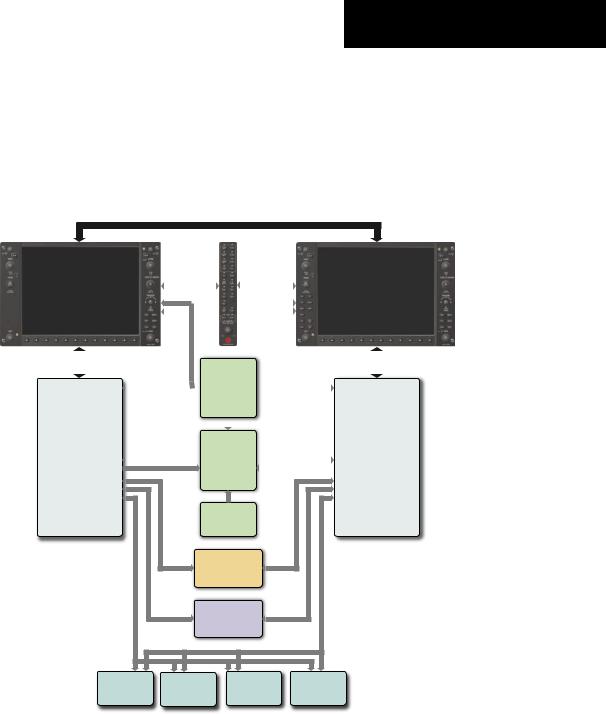
|
|
SYSTEM OVERVIEW |
|
|
|
1.1 INTRODUCTION |
1.2 SYSTEM DESCRIPTION |
|
This System Overview Pilot’s Guide provides a basic description of the G1000 System as it pertains to the Beechcraft 58/G58. The description includes the Garmin Automatic Flight Control System (AFCS).
This section gives a brief description of the G1000 System. A G1000 system block diagram is given in Figure 1-1. Refer to the Pilot’s Guide Appendices for LRU specifications.
High-Speed Data Bus (Ethernet)
Reversionary |
|
Reversionary |
Control |
|
Control |
|
|
|
|
|
|
|
|
|
|
|
|
|
|
|
|
GDC 74A |
|
|
|
|
|
|
|
|
|
|
|
|||
|
|
|
|
|
|
|
|
|
|
|
|
|
|
|
|
|
|
|
|
|
||||
|
|
|
|
|
|
|
|
|
|
|
|
|
|
|
|
|
|
|
|
|
||||
|
|
|
|
|
|
|
|
|
|
|
|
|
|
|
|
|
|
|
|
|
||||
|
|
|
|
|
|
|
|
|
|
Air Data |
|
|
|
|
|
|
|
|
|
|
|
|||
No. 1 GIA 63 |
|
|
|
|
|
|
Computer |
|
|
|
|
|
|
|
No. 2 GIA 63 |
|||||||||
Integrated Avionics Unit |
|
|
|
|
|
|
OAT |
|
|
|
|
|
|
|
Integrated Avionics Unit |
|||||||||
|
|
|
|
|
|
Airspeed |
|
|
|
|
|
|
|
|||||||||||
|
|
|
|
|
|
|
|
|
|
|
|
|
|
|
|
|
|
|
|
|
||||
System Inegration Processors |
|
|
|
|
|
|
Altitude |
|
|
|
|
|
|
|
System Integration Processors |
|||||||||
|
|
|
|
|
|
Vertical Speed |
|
|
|
|
|
|
|
|||||||||||
I/O Processors |
|
|
|
|
|
|
|
|
|
|
|
|
|
I/O Processors |
||||||||||
|
|
|
|
|
|
|
|
|
|
|
|
|
|
|
|
|
||||||||
VHF COM |
|
|
|
|
|
|
|
|
|
|
|
|
|
|
|
|
|
VHF COM |
||||||
VHF NAV/LOC |
|
|
|
|
|
|
GRS 77 |
|
|
|
|
|
|
|
VHF NAV/LOC |
|||||||||
GPS |
|
|
|
|
|
|
|
|
|
|
|
|
|
|
GPS |
|||||||||
|
|
|
|
|
|
AHRS |
|
|
|
|
|
|
|
|
||||||||||
Glideslope |
|
|
|
|
|
|
|
|
|
|
|
|
|
Glideslope |
||||||||||
|
|
|
|
|
|
|
|
|
|
|
|
|
|
|
|
|
||||||||
|
|
|
|
|
|
|
|
|
|
Attitude |
|
|
|
|
|
|
|
|
|
|
|
|
||
|
|
|
|
|
|
|
|
|
|
Rate of Turn |
|
|
|
|
|
|
|
|
|
|
|
|
||
|
|
|
GPS Output |
|
|
|
|
|
|
Slip/Skid |
|
|
|
|
|
|
|
GPS Output |
|
|
|
|||
AFCS Mode Logic
Flight Director Calculation
Servo Communication
Servo Communication
GMU 44
Magnetometer
Heading
GTX 32 or GTX 33
Transponder
GEA 71
Engine/Airframe
Unit
GSA 81 |
81 |
SA 81 |
GSA 81 |
Pitch Servo |
Yaw Servo |
Pitch Trim Servo |
Roll Servo |
Autopilot Calculation |
Autopilot Calculations |
Autopilot Calculations |
Autopilot Calculations |
Figure 1-1 G1000 System Block Diagram
190-00629-00 Rev. B |
Garmin G1000 Pilot’s Guide for the Beechcraft 58/G58 |
1-1 |

SYSTEM OVERVIEW
•GDU 1040/GDU 1043 – The G1000 features two displays, the GDU 1040 and GDU 1043. The GDU 1040 is a 10.4-inch LCD display with 1024 x 768 resolution and is configured as a Primary Flight Display. TheGDU1040displaystheFlightDirector command bars, system annunciations and alerts, pilot-selectable references, and flight information. The GDU 1043 is configured as a Multi Function Display which contains the dedicated AFCS keys and GPS/Navigation controls. The displays com- municatewitheachotherthroughahigh-speeddata bus (HSDB) Ethernet connection. Each display is also paired via an ethernet connection.
•GMA 1347– Installed between the MFD and PFD, the GMA 1347 integrates NAV/COM digital audio, intercom system and marker beacon controls. The GMA1347communicateswithbothGIA 63susing an RS-232 digital interface. The GMA 1347 also controls manual display reversionary mode.
•GIA63–TherearetwoGIA63s.TheGIA 63functionsasamaincommunicationhub,linkingallLRUs with the PFD and the MFD displays. Each GIA 63 containsaGPSreceiver,VHFCOM/NAV/GSreceivers, and system integration microprocessors. Each GIA 63 is paired with a respective display through an ethernet connection. The GIAs are not paired together and do not communicate with each other directly.
Each GIA 63 also contains the AFCS software which controls the Flight Director. During normal operation,theGRS 77AHRSandGDC 74AAirData Computer send attitude and air data information to the GIA 63s. This information, combined with GPS and other system data, is used by the Flight Director and Autopilot. Flight Director commands are calculated within the #1 GIA 63 and are sent to thePFDfordisplayandmodeannunciation. Flight information is also sent to the GSA 81 servos for Autopilotoperation. AGIA #1failure resultsin the loss oftheAFCSsystem. AnyGIA63failure results in loss of the Autopilot function.
•GRS 77 – The GRS 77 is an Attitude and Heading Reference System (AHRS) that provides aircraft attitude and heading information to both the G1000displaysandtheGIA 63s. Theunitcontains advanced sensors, accelerometers and rate sensors. In addition, the GRS 77 interfaces with both the GDC 74A Air Data Computer and the GMU 44 Magnetometer. TheGRS 77alsoutilizesGPSsignals sent from the GIA 63. Attitude and heading informationissentusinganARINC 429digitalinterface to both GDU 1040s and GIA 63s. AHRS modes of operation are discussed later in this document.
•GMU 44 – The GMU 44 Magnetometer measures local magnetic field information. Data is sent to the GRS 77 AHRS for processing to determine aircraft magnetic heading. This unit receives power directly from the GRS 77 and communicates with the GRS 77 using an RS-485 digital interface.
1-2 |
Garmin G1000 Pilot’s Guide for the Beechcraft 58/G58 |
190-00629-00 Rev. B |

•GDC 74A – The GDC 74A Air Data Computer processes information from the pitot/static system aswellastheoutsideairtemperature(OAT)sensor. The GDC 74A provides pressure altitude, airspeed, vertical speed and OAT information to the G1000 system, and communicates with the GIA 63s, GDU 1040sandGRS 77usinganARINC 429digital interface.
•GEA71–TheGEA71receivesandprocessessignals from the engine and airframe sensors. Sensor types includeenginetemperatureandpressuresensorsas wellasfuelmeasurementandpressuresensors. The GEA 71 communicates with both GIA 63s using an RS-485 digital interface.
•GTX 33 – The GTX 33 is a solid-state, Mode-S transponder that provides Modes A, C and S operation. The GTX 33 is controlled through the PFD and communicates with both GIA 63s through an RS-232 digital interface.
•SA 81 AFCS Servos – Four GSA 81 servos are used for automatic control of the aircraft flight control surfaces. One servo is used for the each of the following:
•Pitch
•Roll
•Pitch Trim
•Yaw
SYSTEM OVERVIEW
Each servo moves its respective aircraft control surface in response to commands generated by internalservocalculations. Forpitchtrim,theservo positions the aircraft pitch trim surface in response to commands generated by automatic and manual electric pitch trim calculations. Calculations are performed using data sent through the common serial data bus from the GIA 63. Manual Electric PitchTrimisalsoprovidedinresponsetotheManual Electric Trim (MET) switch.
1.3 OPTIONAL EQUIPMENT
This System Overview only covers the baseline configuration of the G1000. Descriptions and procedures relating to optional equipment is covered in the G1000 OptionalEquipmentsection. ConsultaGarminauthorized service center for optional equipment availability and configuration.
190-00629-00 Rev. B |
Garmin G1000 Pilot’s Guide for the Beechcraft 58/G58 |
1-3 |
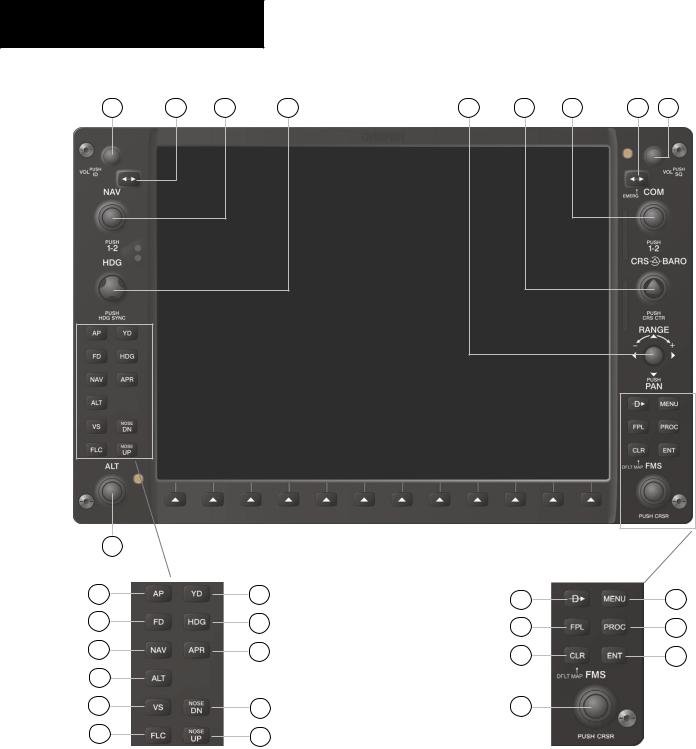
SYSTEM OVERVIEW
1.4 PFD/MFD CONTROLS
1 |
2 |
3 |
4 |
5 |
6 |
7 |
8 |
9 |
17 |
Figure 1-2 |
PFD/MFD Controls |
|
18 |
24 |
10 |
14 |
|
|
||
19 |
25 |
11 |
15 |
20 |
26 |
12 |
16 |
21 |
|
|
|
22 |
27 |
13 |
|
23 |
28 |
|
|
MFD Only
1-4 |
Garmin G1000 Pilot’s Guide for the Beechcraft 58/G58 |
190-00629-00 Rev. B |

Functionality of the PFD and MFD controls are the same with the exception of the dedicated autopilot keys located only on the MFD bezel.
(1)NAV VOL/ID Knob – Controls the NAV audio level. Press to toggle the Morse code identifier ON and OFF. Volume level is shown in the field as a percentage.
(2)NAV Frequency Toggle Key – Toggles the standby and active NAV frequencies.
(3)Dual NAV Knob – Tunes the MHz (large knob) and kHz (small knob) standby frequencies for the NAV receiver. Press to toggle the tuning cursor (light blue box) between the NAV1 and NAV2 fields.
(4)Heading Knob – Turn to manually select a heading on the HSI. When pressed, it synchronizes the heading
bug with the compass lubber line. Selected Heading provides the heading reference to the Flight Director while operating in Heading Select mode.
(5)Joystick – Changes the map range when rotated. Activates the map pointer when pressed.
(6)CRS/BAROKnob–Thelargeknobsetsthealtimeter barometric pressure and the small knob adjusts the course. The course is only adjustable when the HSI is in VOR1, VOR2, or OBS/SUSP mode. Pressing this knob
centers the CDI on the currently selected VOR. Selected Course provides course reference to the Flight Director when operating in Navigation and Approach modes.
(7)Dual COM Knob – Tunes the MHz (large knob) and kHz (small knob) standby frequencies for the COM transceiver. Pressing this knob toggles the tuning cursor (light blue box) between the COM1 and COM2 fields.
(8)COM Frequency Toggle Key – Toggles the standby and active COM frequencies. Pressing and holding this key for two seconds automatically tunes the emergency frequency (121.5 MHz) in the active frequency field.
(9)COM VOL/SQ Knob – Controls COM audio level. Pressing this knob turns the COM automaticsquelch ON and OFF. Audio volume level is shown in the field as a percentage.
SYSTEM OVERVIEW
(10)Direct-to Key – Allows the user to enter a destination waypoint and establish a direct course to the selected destination (specified by the identifier, chosen from the active route, or taken from the map cursor position).
(11)FPL Key – Displays the active Flight Plan Page for creatingandeditingtheactiveflightplan,orforaccessing stored flight plans.
(12)CLR Key (DFLT MAP) – Erases information, cancels an entry, or removes page menus. To display the Navigation Map Page immediately, press and hold CLR (MFD only).
(13)Dual FMS Knob – Used to select the page to be viewed(onlyontheMFD). Thelargeknobselectsapage group (MAP, WPT, AUX, NRST), while the small knob selects a specific page within the page group. Pressing the small knob turns the selection cursor ON and OFF. When the cursor is ON, data may be entered in the different windows using the smalland large knobs. The large knob is used to move the cursor on the page, while the small knob is used to select individual characters for the highlighted cursor location. When the G1000 displays a list that is too long for the display screen, a scroll bar appears along the right side of the display, indicating the availability of additional items within the selected category. Press the FMS/PUSH CRSR knob to activate the cursor and turn the large FMS knob to scroll through the list.
(14)MENU Key – Displays a context-sensitive list of options. This list allows the user to access additional features, or to make setting changes that relate to certain pages.
(15)PROC Key – Selects approaches, departures and arrivals from the flight plan. If a flight plan is used, available procedures for the departure and/or arrival airport are automatically suggested. If a flight plan is not used, the desired airport and the desired procedure may be selected. This key selects IFR departure procedures
190-00629-00 Rev. B |
Garmin G1000 Pilot’s Guide for the Beechcraft 58/G58 |
1-5 |

SYSTEM OVERVIEW
(DPs), arrival procedures (STARs) and approaches (IAPs) from the database and loads them into the active flight plan.
(16)ENT Key – Accepts a menu selection or data entry. This key is used to approve an operation or complete data entry. It is also used to confirm selections and information entries.
(17)Dual ALT Knob – Sets the reference altitude in the box located above the Altimeter. The large knob selects the thousands, while the small knob selects the hundreds. Selected altitude provides an altitude setting for the Altitude Capture/Hold mode, in addition to the standard G1000 altitude alerter function.
(18)AP Key – Engages/disengages the Autopilot and Flight Director in the default vertical and lateral modes.
(19)FD Key – Activates/deactivates the Flight Director only. Pressing the FD key turns on the Flight Director in the default vertical and lateral modes. Pressing the FD key again deactivates the Flight Director and removes the command bars, unless the Autopilot is engaged. If the Autopilot is engaged, the FD key is disabled.
(20)NAV Key – Selects/deselects the Navigation mode.
(21)ALT Key – Selects/deselects the Altitude Hold
mode.
(22)VS Key – Selects/deselects the Vertical Speed mode.
(23)FLC Key – Selects/deselects the Flight Level Change mode.
(24)YD Key – Engages/disengages the Yaw Damper.
(25)HDG Key – Selects/deselects the Heading Select mode.
(26)APR Key – Selects/deselects the Approach mode.
(27, 28) NOSE UP/NOSE DN Keys – Controls the active pitch reference for the Pitch Hold, Vertical Speed, and Flight Level Change modes.
1.5 SECURE DIGITAL CARDS
The GDU 1040 data card slots use Secure Digital (SD) cards. SD cards are used for aviation database updates and terrain database storage.
To install an SD card:
1.Insert the SD card in the SD card slot located on the right side of the display bezel (the front of the card should be flush with the face of the display bezel).
To remove an SD card:
1.Gently press on the SD card to release the spring latch and eject the card.
NOTE: Refer to the Pilot’s GuideAppendices for instructions on updating the aviation database.
1-6 |
Garmin G1000 Pilot’s Guide for the Beechcraft 58/G58 |
190-00629-00 Rev. B |
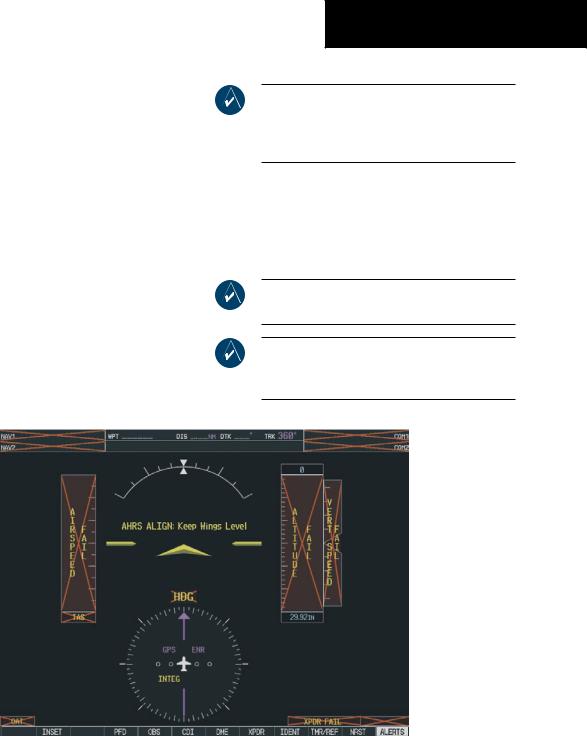
1.6 SYSTEM POWER-UP
The G1000 system is integrated with the aircraft electricalsystemandreceivespowerdirectlyfromelectrical busses. The Garmin G1000 PFD/MFD and supporting sub-systems include both power-on and continuous builtin test features that exercise the processor, RAM, ROM, external inputs and outputs to provide safe operation.
Whilethesystembeginstoinitialize,testannunciations are displayed to the pilot at power-up, as shown in the figure below. All system annunciations should be cleared within one (1) minute of power-up. The GMA 1347 also annunciates all bezel lights briefly upon power-up.
SYSTEM OVERVIEW
NOTE: Refer to the Beechcraft 58/G58 Pilot’s OperatingHandbook(POH)forspecificprocedures concerning avionics power application and emergency power supply operation.
On the PFD, the AHRS system displays the ‘AHRS ALIGN:KeepWingsLevel’messageandbeginstoinitialize. The AHRS should display valid attitude and heading fields within one (1) minute of power-up. The AHRS can align itself both while taxiing and during level flight.
NOTE: Refer to the Appendices for AHRS initialization bank angle limitations.
NOTE: See theAnnunciations andAlerts Section for additional information regarding system annunciations and alerts.
Figure 1-3 PFD Initialization Display
190-00629-00 Rev. B |
Garmin G1000 Pilot’s Guide for the Beechcraft 58/G58 |
1-7 |
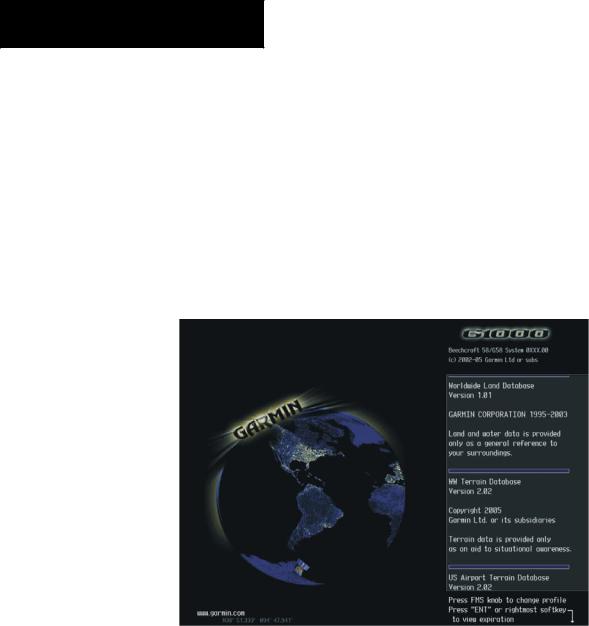
SYSTEM OVERVIEW
When the MFD powers up, the MFD Power-up Page displays the following information:
•System version
•Copyright
•Checklist filename
•Land database name and version
•Obstacle database name and version
•Terrain database name and version
•Aviation database name, version and effective dates
When this information has been reviewed for currency (to ensure that no databases have expired), the pilot is prompted to continue. Current database information is displayed with the valid operating dates, cycle number and database type.
Press the ENT key to acknowledge this information and proceed to the Navigation Map Page.
Figure 1-4 MFD Power-up Page
1-8 |
Garmin G1000 Pilot’s Guide for the Beechcraft 58/G58 |
190-00629-00 Rev. B |
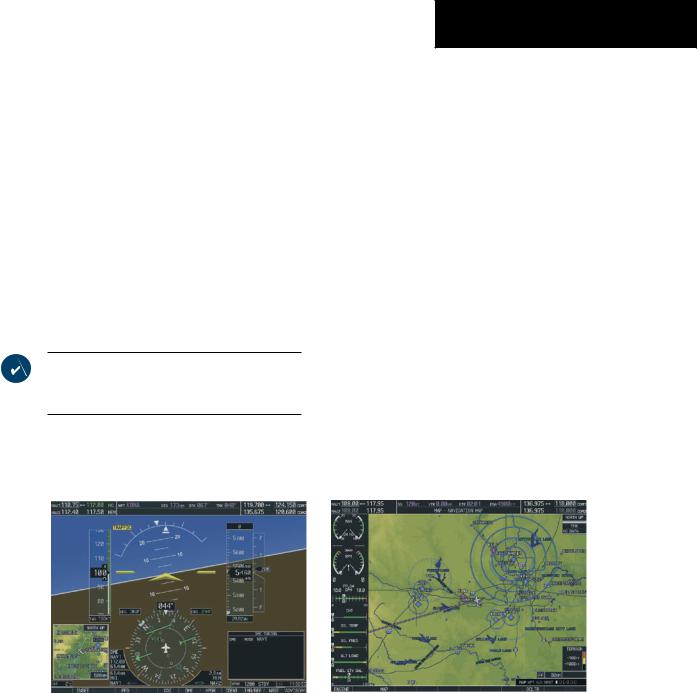
1.7 DISPLAY BACKLIGHTING
The G1000 PFD and MFD displays use photocell technology to automatically adjust for ambient lighting conditions. Photocellcalibrationcurvesarepre-configured to optimize display appearance through a broad range of cockpit lighting conditions. The PFD, MFD, and GMA 1347 bezel/key lighting is typically controlled directly by the existing instrument panel dimmer bus.
If desired, the PFD and MFD display backlighting can be adjusted manually. The PFD, MFD and GMA 1347 bezel/key brightness can also be adjusted manually. The GMA 1347 bezel/key brightness is directly tied to the MFD bezel/key adjustment.
NOTE: Refer to the Primary Flight Display section for instructions on adjusting backlighting manually.
SYSTEM OVERVIEW
1.8 SYSTEM OPERATION
NORMAL MODE
The PFD and MFD are connected together on a single Ethernet bus, allowing for high-speed communication between the two units. Each GIA 63 is connected to a single display This allows the units to share information, thus enabling true system integration.
In normal operating mode, the PFD displays graphical flight instrumentation instead of the traditional gyro instruments. Attitude, heading, airspeed, altitude and vertical speed are all shown on one display. The MFD shows a full-color moving map with navigation information. BothdisplaysoffercontrolforCOMandNAV frequencyselection,aswellasfortheheading,course/baro and altitude reference functions. On the left of the MFD display, the Engine Indication System (EIS) cluster shows engine and airframe instrumentation. Figure 1-5 gives an example of the G1000 system in normal mode.
Figure 1-5 Normal Mode
190-00629-00 Rev. B |
Garmin G1000 Pilot’s Guide for the Beechcraft 58/G58 |
1-9 |
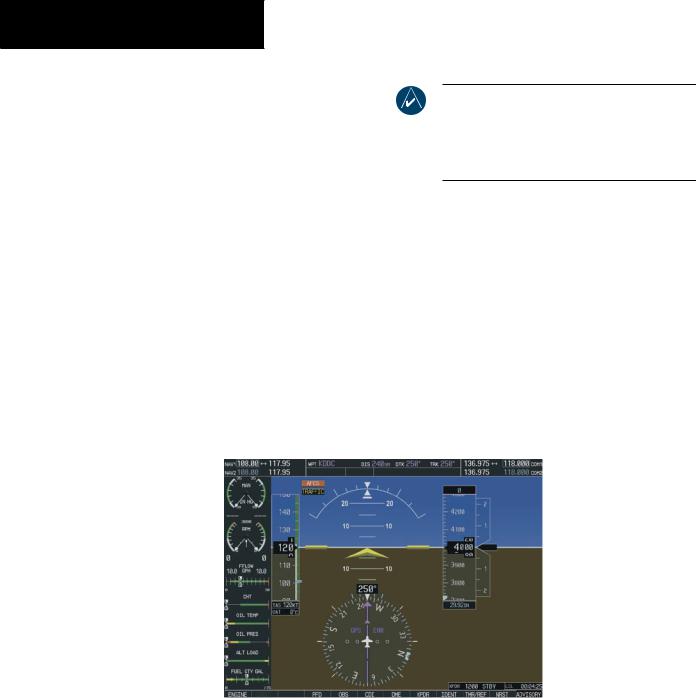
SYSTEM OVERVIEW
REVERSIONARY MODE
Should a failure occur in either display, the G1000 automatically enters reversionary mode. In reversionary mode, all important flight information is shown on the remaining display. An example of reversionary mode entry due to a failed PFD is shown in Figure 1-6.
If a display fails, the GIA 63-GDU 1040 Ethernet interface is cut off. Thus, the GIA can no longer communicate with the remaining display, and the NAV and COM functions provided to the failed display by the GIA are flagged as invalid on the remaining display. The system reverts to using backup paths for the GRS 77, GDC 74A, GEA 71 and GTX 33, as required. The change to backup paths is completely automated for all LRUs, and no pilot action is required.
NOTE: The system alerts the pilot when backup paths are utilized by the LRUs. Refer to the Annunciations andAlerts Pilot’s Guide for further information regarding these and other system alerts.
Reversionary mode may also be manually activated by the pilot if the system fails to detect a display problem. Reversionary mode is activated manually by pressing the red DISPLAY BACKUP button at the bottom of the GMA 1347 Audio Panel. Pressing this button again deactivates reversionary mode.
AFCS PREFLIGHT TEST
WhenpowerisappliedtotheG1000,theAFCSsystem starts preflight system tests. ‘PFT’ is annunciated on the PFD at the AFCS System Status field. The Autopilot disconnect aural alert tone sounds at the end of the test and the ‘PFT’ annunciation disappears.
Figure 1-6 Reversionary Mode
1-10 |
Garmin G1000 Pilot’s Guide for the Beechcraft 58/G58 |
190-00629-00 Rev. B |

AHRS OPERATION
In addition to using internal sensors, the GRS 77 AHRS uses GPS information, magnetic field data and air data to assist in attitude/heading calculations. In normal (primary) mode, the AHRS relies upon GPS and magnetic field measurements. If either of these external measurements is unavailable or invalid, the AHRS uses air data information for attitude determination. Four AHRS modes of operation are available (see table below) and depend upon the combination of available sensor inputs. Loss of air data, GPS, or magnetometer sensor inputs is communicated to the pilot by message advisory alerts.
GPS Input Failure
The G1000 system provides two sources of GPS information. If a single GPS receiver fails, or if the information provided from one of the GPS receivers is unreliable, the AHRS seamlessly transitions to using the other GPS receiver. An alert message informs the pilot of the use of the backup GPS path. If both GPS inputs fail, the AHRS continues to operate in reversionary ‘No GPS’ mode so long as the air data and magnetometer inputs are available and valid.
SYSTEM OVERVIEW
Air Data Input Failure
A failure of the air data input has no effect on AHRS output while AHRS is operating in normal/primary mode. A failure of the air data input while the AHRS is operating in reversionary ‘No GPS’ mode results in invalid attitude and heading information on the PFD (as indicated by red ‘X’ flags).
Magnetometer Failure
If the magnetometer input fails, the AHRS transitions to one of the reversionary ‘No Magnetometer’ modes and continues to output valid attitude information. However, the heading output on the PFD does become invalid (as indicated by a red ‘X’).
NOTE: Please refer to the Annunciations and Alerts Pilot’s Guide for specific AHRS alert information.
NOTE: Pilots should be aware that aggressive maneuvering in any of the three reversionary modes listed below can degrade AHRS accuracy.
|
Available AHRS Functions |
|
Available Sensor Inputs |
||||
AHRS Mode |
Pitch |
Roll |
|
GPS Input |
GMU 44 |
GDC 74A |
|
|
|
(At least one) |
Magnetometer |
Air Data Computer |
|||
|
|
|
|
||||
Normal/Primary |
X |
X |
X |
X |
X |
X |
|
Reversionary: |
X |
X |
X |
- |
X |
X |
|
No GPS |
|||||||
|
|
|
|
|
|
||
Reversionary: |
X |
X |
- |
X |
- |
X |
|
No Magnetometer |
|||||||
|
|
|
|
|
|
||
Reversionary: |
|
|
|
|
|
|
|
No Magnetometer |
X |
X |
- |
X |
- |
- |
|
No Air Data |
|
|
|
|
|
|
|
190-00629-00 Rev. B |
Garmin G1000 Pilot’s Guide for the Beechcraft 58/G58 |
1-11 |

SYSTEM OVERVIEW
This page intentionally left blank
1-12 |
Garmin G1000 Pilot’s Guide for the Beechcraft 58/G58 |
190-00629-00 Rev. B |

G1000TM
Primary Flight Display
Garmin G1000 Pilot’s Guide for Beechcraft 58/G58 |
190-00629-00 Rev. B |

2.1 INTRODUCTION
WARNING:Intheeventthattheairspeed,attitude, altitude,orheadingindicationsbecomeunusable, please refer to the backup instruments.
This section describes the major features of the G1000 PrimaryFlightDisplay(PFD)asinstalledonBeechcraft58/ G58 aircraft. Information is displayed using the G1000’s two 10.4-inch color flat-panel displays. During normal operation,theleftdisplayis configuredasaPrimaryFlight Display.
The PFD provides increased situational awareness by replacing the traditional instrument “six pack” on the pilot’s panel with an easy-to-scan display that provides a large horizon and airspeed, attitude, altitude, vertical speed, navigation, communication, annunciation, terrain, traffic, and lightning (optional) information. The PFD also controls the operation of the transponder, the selection of NAV/COM frequencies, audio volume, and many navigation features. The operation of these features is explained in other supporting sections.
The G1000 system controls were designed so that, regardless of which seat the pilot is flying from, the aircraft can be flown with one hand and the controls manipulated with the other hand.
PRIMARY FLIGHT DISPLAY
The PFD displays the following:
•Flight Instruments (2.4)
–Airspeed Indicator with True Airspeed Box
–Attitude and Slip/Skid Indicators
–Altimeter with Selected Altitude and Barometric Setting Boxes
–Vertical Deviation/Glideslope Indicator
–Marker Beacon Annunciations
–Vertical Speed Indicator
–Horizontal Situation Indicator
-Turn Rate Indicator
-Bearing Pointers and Information Windows
-DME Information Window (optional)
-Radio Tuning Window (if DME equipped)
-Navigation Source
•Communication, Navigation, and Surveillance (CNS) Information (2.5)
–Communication Frequency Window
–Navigation (NAV) Frequency Window
–Navigation Status Bar
–Transponder Status Bar
•Supplemental Flight Data (2.6)
–Outside Air Temperature Box
–System Time Box
–Inset Map
–Auxiliary Windows
-Timer/References Window
-Nearest Airports Window
-Direct-to Window
-Flight Plan Window
-Procedures Window
•Alerts and Annunciations (2.8)
–Alerts Window
–Annunciation Window
–Terrain Awareness and Warning System (TAWS) Alert Annunciations
–Traffic Annunciation
190-00629-00 Rev. B |
Garmin G1000 Pilot’s Guide for Beechcraft 58/G58 |
2-1 |

PRIMARY FLIGHT DISPLAY
1 |
19 |
18 |
17 |
16 |
15 |
|
14 |
2 |
13 |
|
12 |
3 |
11 |
4 |
10 |
|
|
5 |
9 |
|
|
6 |
8 |
|
|
7 |
|
1 |
NAV Frequency Window |
11 |
Barometric Setting Box |
2 |
Airspeed Indicator |
12 |
Vertical Speed Indicator |
3 |
True Airspeed Box |
13 |
Altimeter |
4 |
Heading Box |
14 |
Selected Altitude Box |
5 |
Horizontal Situation Indicator |
15 |
COM Frequency Window |
6 |
Outside Air Temperature Box |
16 |
TAWS Alert Annunciation |
7 |
Softkeys |
17 |
Navigation Status Bar |
8 |
System Time Box |
18 |
Slip/Skid Indicator |
9 |
Transponder Status Bar |
19 |
Attitude Indicator |
10 |
Turn Rate Indicator |
|
|
Figure 2-1 Default PFD Information
2-2 |
Garmin G1000 Pilot’s Guide for Beechcraft 58/G58 |
190-00629-00 Rev. B |
